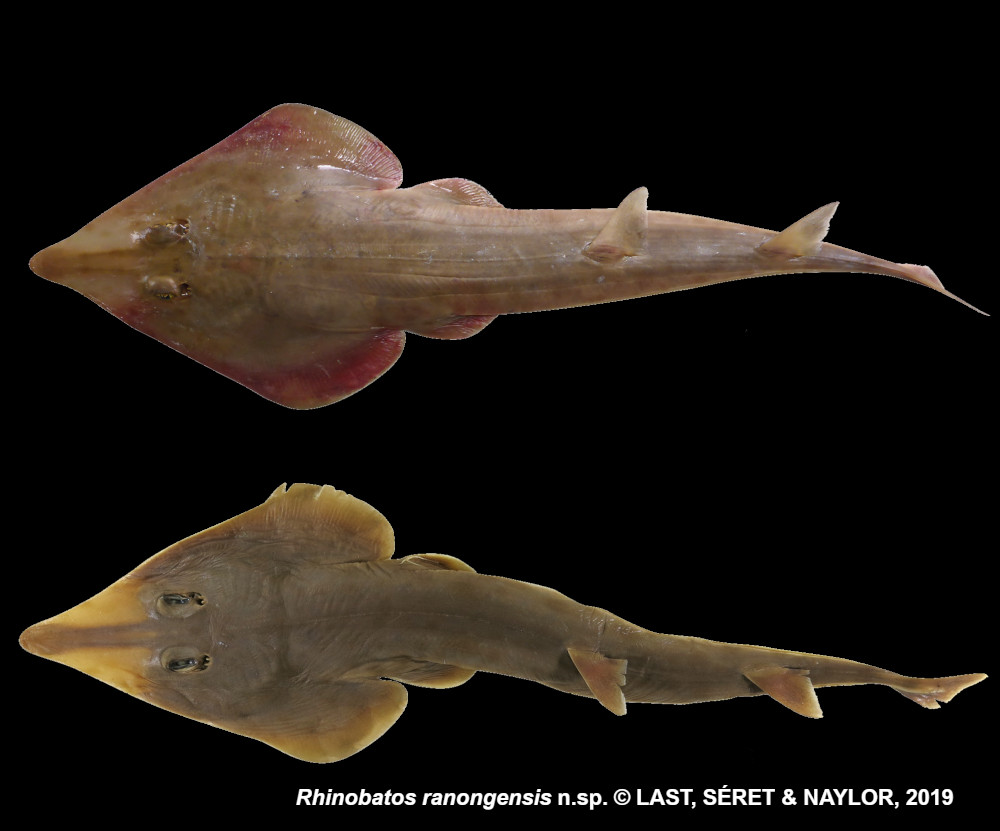Rhinobatos ranongensis
Last, Séret & Naylor, 2019
Classification: Elasmobranchii Rhinopristiformes Rhinobatidae
Reference of the original description
Description of Rhinobatos ranongensis sp. nov. (Rhinopristiformes: Rhinobatidae) from the Andaman Sea and Bay of Bengal with a review of its northern Indian Ocean congeners. Zootaxa, 4576(2), 257–287
Description of Rhinobatos ranongensis sp. nov. (Rhinopristiformes: Rhinobatidae) from the Andaman Sea and Bay of Bengal with a review of its northern Indian Ocean congeners. Zootaxa, 4576(2), 257–287
Types
Rhinobatos ranongensis
Holotype: CSIRO: H 7861-02 (GN 17091); Paratype: ANSP: 171546; CSIRO: H 8403-01 (formerly SA005); CSIRO: H 8404-01 (formerly SA043); CSIRO: H 8404-02 (formerly SA045);
Rhinobatos ranongensis
Holotype: CSIRO: H 7861-02 (GN 17091); Paratype: ANSP: 171546; CSIRO: H 8403-01 (formerly SA005); CSIRO: H 8404-01 (formerly SA043); CSIRO: H 8404-02 (formerly SA045);
Description :
Citation: Rhinobatos ranongensis Last, Séret & Naylor, 2019: In: Database of modern sharks, rays and chimaeras, www.shark-references.com, World Wide Web electronic publication, Version 04/2024
Please send your images of "Rhinobatos ranongensis" to info@shark-references.com

Rhinobatos ranongensis Last, Séret & Naylor, 2019; top: adult male holotype, 645 mm TL (CSIRO H 7861-02), freshly caught; down: adult male paratype, 637 mm TL (ANSP 171546), preserved © Last, Séret & Naylor, 2019

Rhinobatos ranongensis Last, Séret & Naylor, 2019; top: adult male holotype, 645 mm TL (CSIRO H 7861-02), freshly caught; down: adult male paratype, 637 mm TL (ANSP 171546), preserved © Last, Séret & Naylor, 2019
Common names
 Ranong Guitarfish
Ranong Guitarfish
 Ranong Guitarfish
Ranong Guitarfish
Short Description
Diagnose after LAST, SÉRET & NAYLOR, 2019 [27190]: A medium-sized species of the genus Rhinobatos (attaining at least 645 mm TL) distinguished by the following combination of characters in adult male: disc wedge-shaped, relatively narrow, width 31–33% TL, length 1.3–1.4 times width; snout moderately elongate, length 3.0–3.2 times interspiracular distance, 4.1–4.4 times interorbital width; orbit and spiracular openings small, orbit diameter ~1.5 times spiracle length; nostrils weakly oblique, their length 1.3–1.6 times internarial distance; mouth narrow, 5.4–6.0% TL; preoral length 6.3–6.9 times internarial distance; posterior nasal flaps broad; two spiracular folds, outermost fold slightly taller than inner fold; ridges of rostral cartilage almost parallel, converging anteriorly but not constricted medially; anterior cartilage broadly sickle shaped, truncate posteriorly; gill slits and their interspaces narrow, distance between fifth gill slits 3.0–3.2 times in ventral head length; prebranchial sensory pore system obvious, extending to just behind margin of first gill slit; postscapular sensory canal indistinct, deeply embedded, not forming shallow groove; thorn patches on supraorbit and scapular region, and row along dorsal midline rudimentary, not conspicuous; denticles on dorsal fins densest anteriorly, present but more sparse posteriorly; dorsal fins small, height of first 5.4–6.2% TL; pelvic-fin inner margin subequal to its base length; interdorsal distance 2.9–3.3 times first dorsal-fin base; dorsal caudal margin 2.0–2.4 times preventral margin; upper jaw with 68–82 tooth rows; snout angle 59–64°; 64–68 pectoral radials; 172–176 post-synarcual centra; 47–48 nasal lamellae; dorsal fins brownish anteriorly, dusky posteriorly; dorsal disc of adults largely uniformly brownish, without spots or obvious blotches; no large, black, teardrop marking on undersurface of snout.
Diagnose after LAST, SÉRET & NAYLOR, 2019 [27190]: A medium-sized species of the genus Rhinobatos (attaining at least 645 mm TL) distinguished by the following combination of characters in adult male: disc wedge-shaped, relatively narrow, width 31–33% TL, length 1.3–1.4 times width; snout moderately elongate, length 3.0–3.2 times interspiracular distance, 4.1–4.4 times interorbital width; orbit and spiracular openings small, orbit diameter ~1.5 times spiracle length; nostrils weakly oblique, their length 1.3–1.6 times internarial distance; mouth narrow, 5.4–6.0% TL; preoral length 6.3–6.9 times internarial distance; posterior nasal flaps broad; two spiracular folds, outermost fold slightly taller than inner fold; ridges of rostral cartilage almost parallel, converging anteriorly but not constricted medially; anterior cartilage broadly sickle shaped, truncate posteriorly; gill slits and their interspaces narrow, distance between fifth gill slits 3.0–3.2 times in ventral head length; prebranchial sensory pore system obvious, extending to just behind margin of first gill slit; postscapular sensory canal indistinct, deeply embedded, not forming shallow groove; thorn patches on supraorbit and scapular region, and row along dorsal midline rudimentary, not conspicuous; denticles on dorsal fins densest anteriorly, present but more sparse posteriorly; dorsal fins small, height of first 5.4–6.2% TL; pelvic-fin inner margin subequal to its base length; interdorsal distance 2.9–3.3 times first dorsal-fin base; dorsal caudal margin 2.0–2.4 times preventral margin; upper jaw with 68–82 tooth rows; snout angle 59–64°; 64–68 pectoral radials; 172–176 post-synarcual centra; 47–48 nasal lamellae; dorsal fins brownish anteriorly, dusky posteriorly; dorsal disc of adults largely uniformly brownish, without spots or obvious blotches; no large, black, teardrop marking on undersurface of snout.
Dentition
Teeth small, blunt, crowns rhomboidal; teeth quincuncial, 80 (68–69 in paratypes) rows in upper jaw and ~73 rows in lower jaw of holotype; upper and lower jaw teeth similar in shape and size. [27190]
Teeth small, blunt, crowns rhomboidal; teeth quincuncial, 80 (68–69 in paratypes) rows in upper jaw and ~73 rows in lower jaw of holotype; upper and lower jaw teeth similar in shape and size. [27190]
Remarks
shark-references Species-ID=15429
shark-references Species-ID=15429















